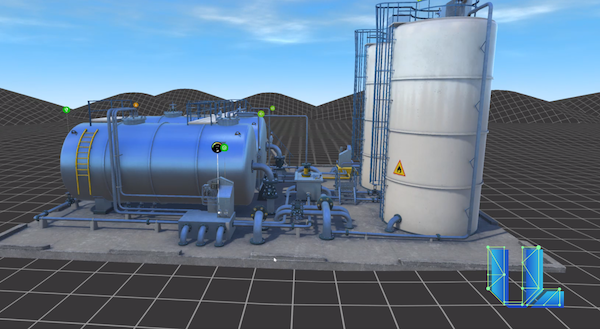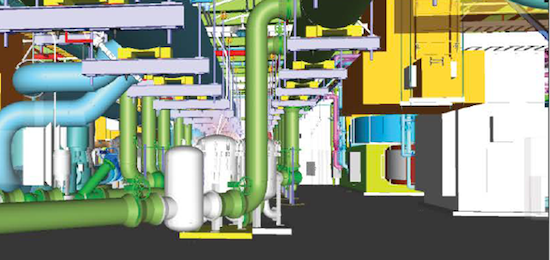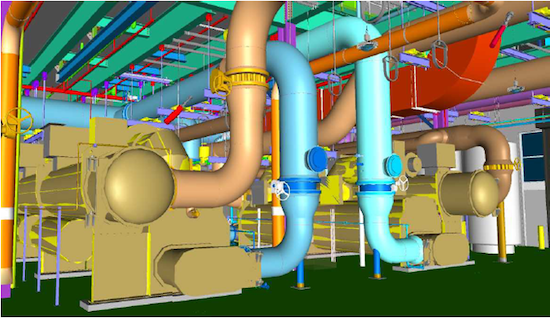Digital Twins and the Pursuit of Efficient and Optimal Power
Could the technology help reduce risk and increase resiliency for power grids?

Digital twins, along with complex modeling and simulation tools, are being widely used to more accurately plan and design systems that operate in a dynamic environment such as a changing climate. Images courtesy of Jim Romeo.
Latest News
June 24, 2021
A rooftop plan for a Tier III 40,000-sq.-ft. data center was designed by an engineering firm that used digital twin software to incorporate the most advanced cooling systems and design features possible.
Using the software, designers were able to model the external environment and run simulation iterations against the digital twin to gain confidence that the cooling system they planned to install was of sufficient capacity and resilient enough to accommodate any requirements.
Digital twins, along with complex modeling and simulation tools, are being widely used to more accurately plan and design systems that operate in a dynamic environment such as a changing climate. Climates include power grids within the confines of an industrial facility, a data center in a hot geographic location or a power grid in Texas during the dead of winter. Digital twins are a new tool and asset that are becoming a discernible value-add to engineering design.
A Predictive Platform
A digital twin software is a predictive software that uses science-based data to provide full visibility into the characteristics of a data center’s operations. It’s a decision-making platform that manages risk by providing true-to-life physics-based information that impacts day-to-day operations on its business goals.
The digital twin is specifically designed to replicate the physical behavior of a data center in a fully simulated environment that allows any touchpoint taking place in the facility to understand its impact on the overall facility functions.
Data center operators can now digitally replicate the entire data center at a fraction of the cost of mirroring an entire physical site. The digital twin enables companies to quickly adapt to ensure operations and business goals align, unlock greater efficiencies and cost savings, and improve performance for every job function within the data center.
This approach has disrupted traditional approaches to data center management by predicting the performance impact of any proposed design or operational change. It also ensures that business practices smartly align with the business and financial implications, to provide holistic control of the entire data center environment.
“In the past, data centers were able to operate for longer without significantly impacting business performance,” says Hassan Moezzi, CEO of Future Facilities. “Today, this is no longer the case. The pace of business has escalated to the point at which every change in the data center has the potential to harm the very reasons a data center exists—business continuity and capacity.”
Having these digital tools and solutions help design decisions that have not been made holistically, but rather in silos, obstructing collaboration between different stakeholders in the design of a data center.
He says that the digital twin is a “virtual world where, through the power of simulation, the stakeholders in data center management are able to foresee both the technical and business impacts of their decisions.”
Data Driven
John Burton is the CEO of UrsaLeo, an enterprise software company that enables users to visualize operational data in a photorealistic 3D representation of their facility or product. He characterizes the digital twin as an ideal tool to predict the real world, based on the virtual world.
“In its simplest form, a digital twin is a set of numbers that in some way represent the real world and therefore can be used in a variety of ways to model scenarios, predict outcomes and be subject to analysis,” says Burton.
Burton says his team combines data with accurate 3D models of the power grid elements to produce a twin that human beings can interpret visually and identify problems very quickly.
“This solves problem number one: being simply overwhelmed with data in such a complex environment and therefore unable to triage problems effectively as your senses simply cannot process the data coming in quickly enough,” he says.

Using digital twins to simulate and model power requirements – whether they are big or small, is a smart practice.
Burton says that creating a 3D realistic twin with data driven visualizations is the first application of digital twins for power designs and dilemmas they may have in optimizing designs for power configurations. This allows controllers to rise above the data and be able to see briefly where problems are occurring.
Burton adds that digital twins also helped fix and resolve any discovered problems in the most efficient manner possible.
“Inevitably, expertise is limited within a power utility,” he says. “There are a certain number of individuals with specialized knowledge, and they are required in many locations at once as problems cascade through the system. Digital twins allow them to collaborate with local less knowledgeable staff and fix problems without having to physically visit every location. This vastly improves the efficiency of maintenance when such an event is occurring.”
Designing with Resilience
“Digital twins paired with smart algorithms like reinforcement learning are the path to creating resilient systems that have been stress tested,” says Chris Nicholson, CEO of Pathmind, a company that applies artificial intelligence to different industrial applications. “They are the best way for responsible leaders to explore how crises will affect their populations, and what they should do to maintain service.”
Nicholson notes that a digital twin is a software replica of a physical system. “They come with visual representations of the twin that allow people to watch the system on a screen,” he says. “Unlike physical systems, digital replicas are flexible. They allow you to stress test the system before the storm comes. They allow you to back test your crisis strategies on historical data. They support ‘what-if’ scenarios where you can test the effects, or more or less equipment, different pricing levels and different population behaviors.”
Using Digital Twins for Large-Scale Power Designs
Ron Beck, energy industry director at AspenTech, a provider of software and services for the process industries. He speaks to the recent outages in Texas, where power grids are independent of commercial grids and ran into trouble when the weather took an uncharacteristic turn and consequently turned out the lights for many.
“The most valuable digital twin to address increasingly dynamic grids with diverse generation and increasingly volatile weather patterns, will be one based on risk and system dependencies,” says Beck.
“For example, the Aspen Fidelis digital twin can model the entire complexity of the grid, look at short-term and long-term weather forecasts, as well as equipment health, and identify the most crucial risk factors in the system. This can drive decisions as to where to invest in the grid itself, into generation and storage, and into adjustments to power pricing, Beck adds.
Another style of digital twin can provide a clear view of what the situation is ‘now,’ in real time, according to Beck. What is happening now? How do I interpret it?
“With a large, unregulated grid, there is myriad of data and information presented to operators,” Beck adds. “A machine learning assisted digital twin helps make sense quickly of a complexity of information.”
A third style of digital twin, according to Beck, can provide predictive information. When are outages predicted to occur across the entire system, why and what are the strategies to avoid those outages?”

Beck explains that the situation in Texas was a bit more complicated. He says the power outages in Texas during the recent cold spell had a lot to do with three issues: decreasing grid predictability, less investment in new capacity and lack of modeling and planning.
First, as a grid gets more deregulated and more renewables and other commercial peak-load generation is incorporated, the grids become less predictable and more dynamic.
“Digital twins will help the operators of the grid understand the complexity of what is going on, industrial AI-based digital twins will help operators understand amidst that complexity, understand where the biggest risks are developing, and digital twins will help planners and managers rapidly examine ‘what-if’ scenarios to make better and faster decisions about the right moves,” Beck says, noting that generally, grids are not prepared from a digitalization vantagepoint, to predict and contend with the dynamics.
“Second, there has been a shortage of investment in new generating capacity that would provide a buffer,” Beck adds.
He says that digital twins can help investors determine their options to invest with a clearer picture of the economic opportunity and uncertainties, encouraging more production.
In the case of Texas, some industrial producers, such as refiners and chemical producers, announced they had kept plants operating only for the purpose of running their co-generation power plants to supply the grid.
Companies such as Dow Chemical have given public presentations on how their digital twin models of their co-generation plants have enabled them to better manage selling power back to the grid. If all industrial power producers had such digital twins, they could have committed to providing more power back to the grid in such a situation.
“Third, it does not appear that enough modeling or planning was does to look at the overall system risk in the context of stochastic variables such as the weather,” Beck says. “A digital twin of the entire system that incorporates such risk factors into the probability modeling could have provided better long-range worst-case planning.”
Embracing Digital Tools
Using digital twins to simulate and model power requirements is a smart practice. Whether it is a power generation source at an industrial facility such as Ford Motor Company, or the sensitive and critical power requirements of a new data center, digital twins can provide solutions that just were not possible only a few years ago.
The resilience and contingency scenarios they allow are invaluable in today’s fragile environment where power is critical, but many things can challenge the reliability and availability of power.
Engineering design teams will be smart to adopt digital twins wherever possible when collaborating and designing power configurations and blaze a new trail to the design capabilities they offer.
Jim Romeo is a freelance writer based in Chesapeake, VA. Send e-mail about this article to [email protected].
Subscribe to our FREE magazine, FREE email newsletters or both!
Latest News
About the Author
Jim Romeo is a freelance writer based in Chesapeake, VA. Send e-mail about this article to [email protected].
Follow DE





